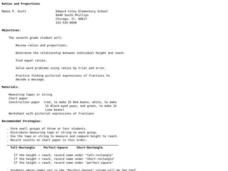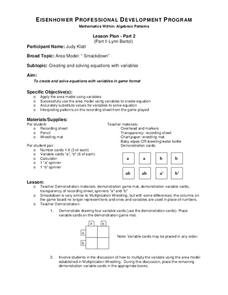Curated OER
Graphing With Second Graders
Second graders sort M & M's and then enter the data into a spreadsheet in order to create a simple graph. After printing the spreadsheet generated graph, have students compare the printed graph with their paper graph.
Curated OER
The Male Reproductive System
Students name the different parts of the male reproductive system. In this health science lesson, students research health issues affecting the male reproductive system. They create a presentation and share it to class.
Curated OER
Muscle Movements
High schoolers participate in a game to identify major muscle groups in the body and gain an understanding of muscle functions.
Curated OER
Ratios and Proportions
Seventh graders explore the concept of ratios and proportions. For this ratios and proportions lesson, 7th graders work in groups to measure their heights and their arm span. Students compare their height to their arm span. Students make...
Curated OER
Ima's Dream
Students compile a list of items on which a person can spend money, categorize a list of items based upon similarities, and solve mathematical problems based upon given scenarios.
Curated OER
Collocation Patterns in English
In this preposition worksheet, students cross out incorrect prepositions in sentences and write the correct preposition above. Page includes teacher instructions for related activities and student reference pages.
Curated OER
Predicting the Greening of Spring With Red Emperor Tulips
Students examine seasonal changes by watching tulip plant growth across the continent utilizing the Journey North website. They develop hypotheses as to why the plants emerge and grow where they do.
Curated OER
Touring My County
Second graders research important events that occurred in their counties for each year they have been alive. They, in groups, categorize these events and develop notes to be used in the writing of an autobiography.
Curated OER
Dr. Seuss: Horton Hears a Who?
Second graders listen to Horton Hears a Who? and complete a study of word cooperation. They group the words into families to see chunking.
Curated OER
Name Count and Graph
Students find the frequency of a name in selected states by using the Internet. They input data into a spread sheet. They create a graph that illustrates the gathered information.
Curated OER
Voting in Violence
Students create K/W/L (Know/Want to Know/Learned) charts to study the political violence following Kenya's 2008 presidential elections. They draw connections between this and other events currently taking place around the world.
Curated OER
Horton Hears a Who
Students explore the ways that communities work in the story Horton Hears a Who and compare that to the community in which they live.
Curated OER
Forms Of Knowledge
Students put writing pieces into categories to show different organizational features in writing. In this writing lesson plan, students are shown examples of speeches, poems, editorials, cartoons, parodies, historical fiction, and more.
Curated OER
He punched me
First graders recognize the short vowel U in written and spoken language. Through matching activities, they discriminate the short vowel /u/ from other vowel sounds. Students associate the phoneme with its letter representation and...
Curated OER
Mathematics Within: Algebraic Patterns
Students analyze problem solving techniques for equations with variables by playing a game called "Smackdown". They place variable cards on a grid and use the area model to calculate an answer after spinning a game piece to determine the...
Curated OER
Predicting the Route of the Monarch's Spring Migration
Students consider the habits of the monarch butterfly and predict the path it take as it migrates in the spring.
Utah Education Network
Uen: Setting a Purpose for Reading Using Informational Text
This lesson engages students in using a two-column graphic organizer to take notes. Students will record titles and subtitles and list questions that will correspond with each one.
PBS
Pbs Learning Media: Main Idea and Details Cloud
Students practice distinguishing between relevant and irrelevant ideas by identifying relevant details in a video segment about a wild horse roundup. Students watch the video, read the transcript, and identify details they believe are...
Sophia Learning
Sophia: Types of Proofs: Lesson 3
This lesson will introduce flow chart proofs, paragraph proofs, and two-column proofs, and explain the similarity and differences between the different types of proofs. It is 3 of 5 in the series titled "Types of Proofs."
Toy Theater
Toy Theater: Multiplication Chart 1 to 12
Learn multiplication by using this versatile interactive times table grid. Users can find the product of two numbers from 1 through 12, color in rows and columns, and look for patterns throughout the chart.


















